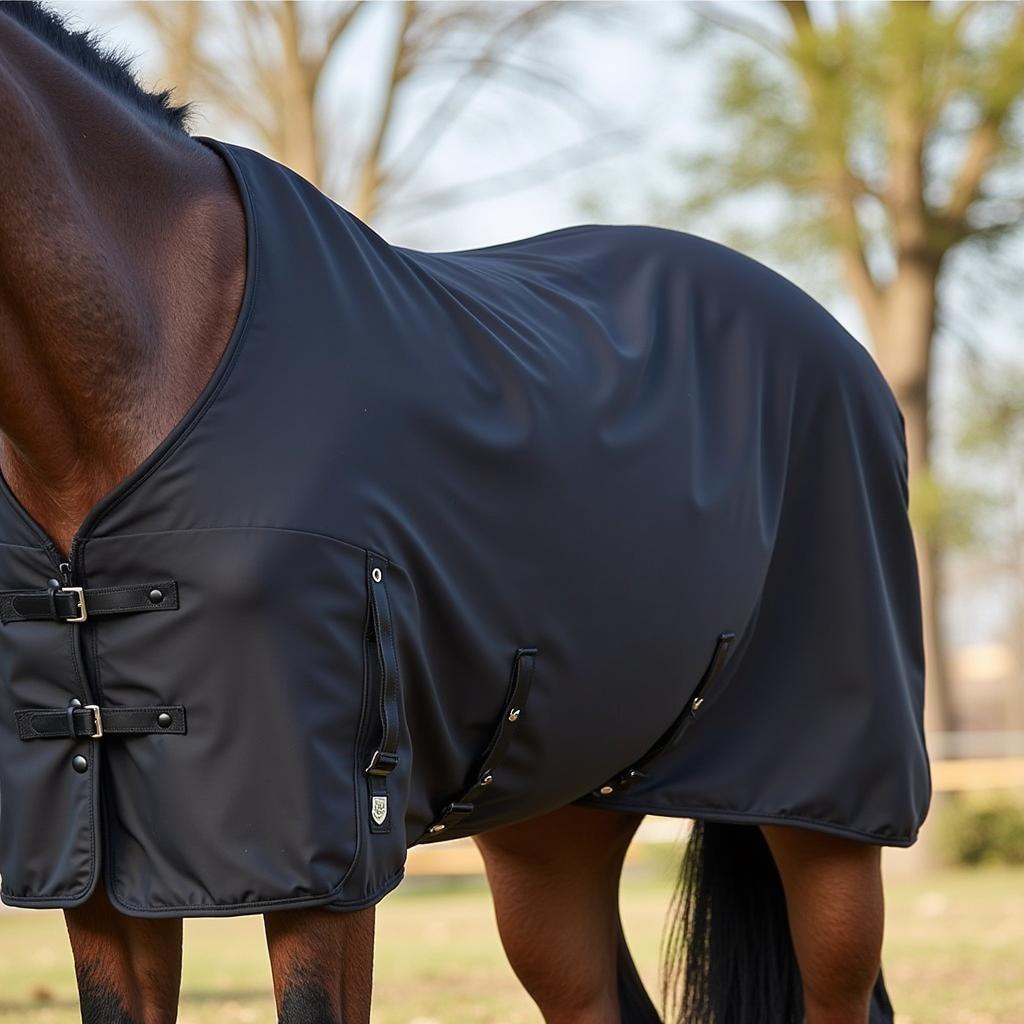Horse Ball Covers are a relatively new product on the market, but they’re already gaining popularity among horse owners and riders. But what exactly are they, and why should you consider using one for your equine companion?
This comprehensive guide dives deep into the world of horse ball covers, exploring their benefits, different types, how to choose the right one, and how to use and care for them.
Understanding the Need for Horse Ball Cover
A horse ball cover, also sometimes referred to as a “horse sheath cover,” is a protective garment designed to shield a horse’s sensitive genital area. While it might seem unusual at first, there are various reasons why horse owners are turning to this innovative product.
 Horse wearing a ball cover for protection
Horse wearing a ball cover for protection
The Benefits of Using a Horse Ball Cover
- Hygiene and Cleanliness: One of the primary reasons horse owners opt for ball covers is to maintain hygiene. These covers help keep the sheath area clean, especially for horses prone to sheath infections or those requiring frequent cleaning.
- Injury Prevention: For horses that tend to kick or bite at themselves, a ball cover can act as a barrier, protecting them from potential self-inflicted injuries.
- Show Ring Presentation: In the show ring, presentation is key. Some owners use ball covers to keep the sheath area clean and tidy, ensuring their horses look their best for competition.
- Medical Purposes: After veterinary procedures involving the sheath area, a ball cover can help protect the healing tissues and prevent contamination.
Different Types of Horse Ball Covers
Just like any other horse equipment, ball covers come in different shapes, sizes, and materials. Understanding the different types will help you choose the best fit for your horse’s needs.
- Neoprene Ball Covers: These are among the most popular choices due to their durability, flexibility, and water-resistant properties. Neoprene conforms to the horse’s body shape, offering a secure and comfortable fit.
- Leather Ball Covers: While less common, leather ball covers provide a more traditional look. They are durable but require proper care and maintenance to prevent cracking or stiffness.
- Mesh Ball Covers: These are ideal for warmer climates as they offer good ventilation, preventing overheating. However, they might not provide as much protection as neoprene or leather covers.
Choosing the Right Horse Ball Cover
Selecting the correct size and type of ball cover is crucial for your horse’s comfort and well-being.
- Sizing: Measure your horse carefully, referring to the manufacturer’s size chart. A cover that’s too tight will cause discomfort and chafing, while a loose one might slip off.
- Material: Consider your horse’s needs and the climate. Neoprene is versatile, leather is durable, and mesh is breathable.
- Fit and Comfort: Choose a cover that fits snugly but not too tightly. Ensure the straps are adjustable and the material doesn’t rub against the horse’s skin.
Using and Caring for Your Horse Ball Cover
Proper use and care will ensure your horse’s ball cover lasts longer and continues to provide optimal protection.
- Introducing the Cover: Allow your horse to get accustomed to the cover gradually. Start by letting them sniff it and then progress to putting it on for short periods.
- Cleaning and Maintenance: Regularly clean the cover according to the manufacturer’s instructions. Most covers can be washed with mild soap and water. Allow them to air dry thoroughly before the next use.
- Inspection: Before each use, check the cover for any signs of wear and tear, such as loose straps, tears, or cracks. Replace damaged covers immediately.
Frequently Asked Questions About Horse Ball Covers
- Q: Can my horse wear a ball cover all the time?
A: While horse ball covers are safe for extended wear, it’s essential to give your horse breaks to prevent any potential skin irritation. - Q: Can I use a ball cover on a mare?
A: Ball covers are specifically designed for male horses. For mares, other protective garments, like tail bags, are available. - Q: How often should I clean my horse’s ball cover?
A: The frequency of cleaning depends on the material and how often it’s used. As a general rule, cleaning after every few uses or when visibly soiled is recommended.
When to Consult a Veterinarian
While horse ball covers are generally safe, it’s crucial to consult your veterinarian if you notice any signs of irritation, discomfort, or swelling in your horse’s sheath area.
For expert advice on horse ball covers and other equine care products, don’t hesitate to contact us at Phone: 0772127271, Email: [email protected]. You can also visit us at QGM2+WX2, Vị Trung, Vị Thuỷ, Hậu Giang, Vietnam. Our dedicated customer support team is available 24/7 to assist you.